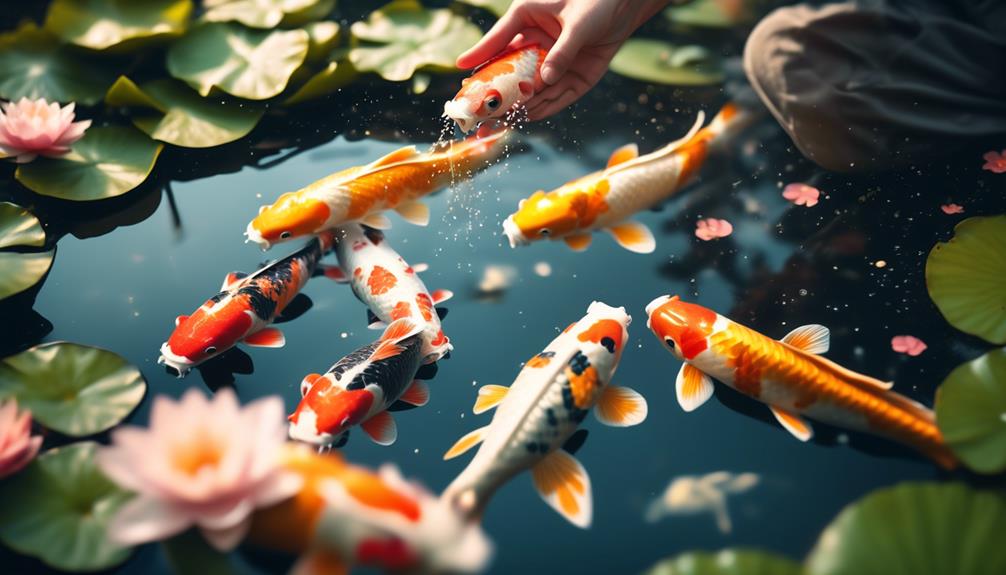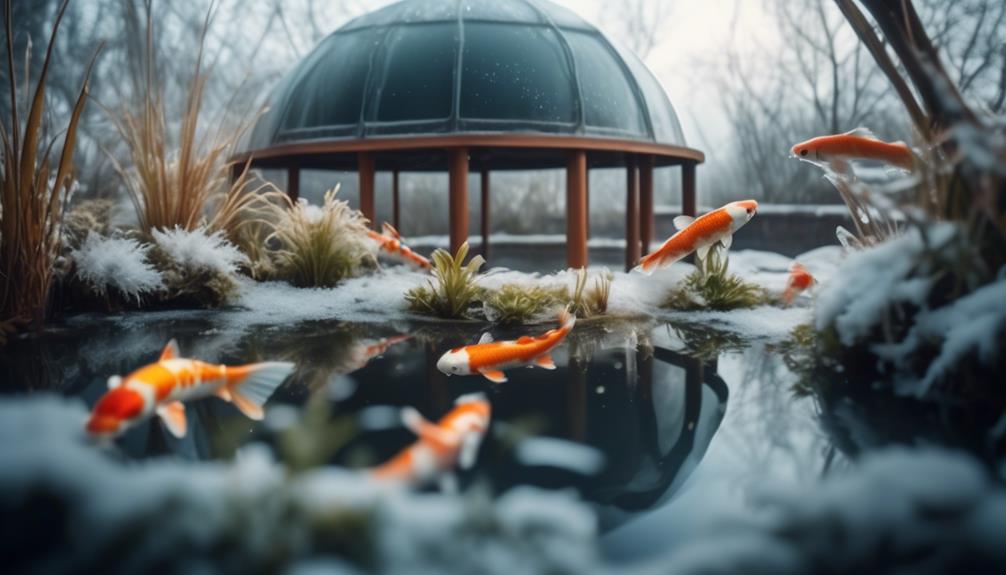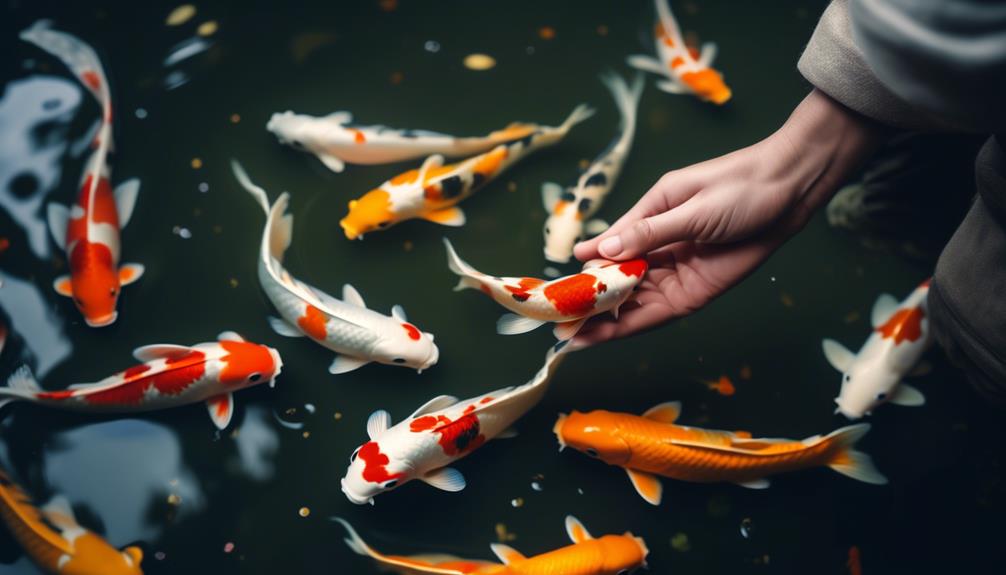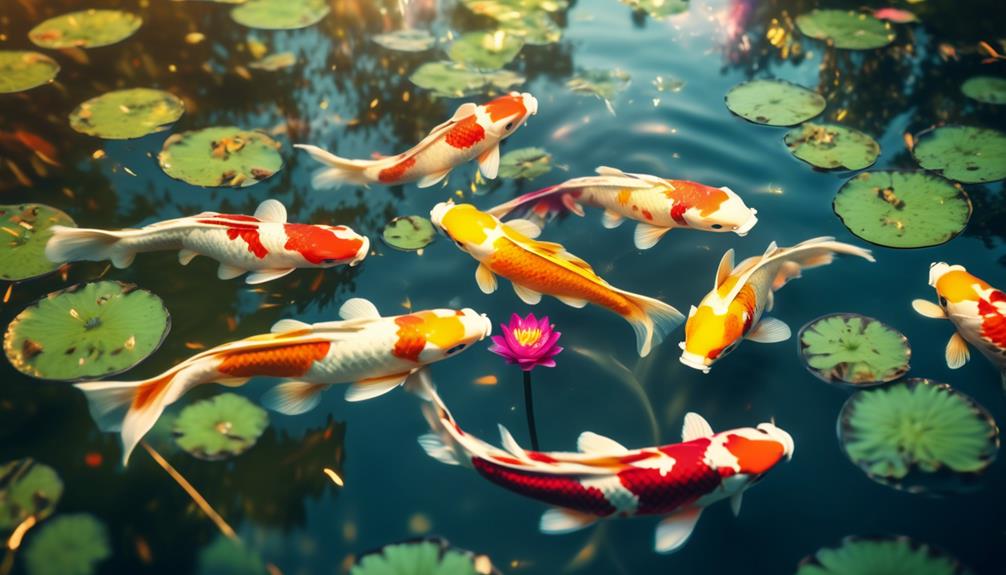In the peaceful world of water gardens, Koi fish bring color and calm as they breed each spring. Caring for baby Koi, also known as fry, requires a lot of attention and knowledge. When it's time for spawning, those who keep Koi get ready to help eggs turn into beautiful fish. It's important to know a lot about how Koi fry grow and what they need to stay healthy. This means choosing strong parent fish and keeping the water clean and at the right temperature. Every step is key for the fry's well-being.
Some of the links in this article may be affiliate links. If you make a purchase through these links, we may earn a small commission at no extra cost to you. Thank you.
Koi keepers enjoy a special bond with their fish. It's not just about the tasks; it's about marveling at life's delicate dance. We're going to look at what it takes to raise Koi fry well. The joy comes from being deeply involved in this process.
Here's what you need to know:
To start, pick parent Koi that are healthy and strong. This gives the fry a good chance at life. Keep the water quality high and the temperature stable. It's usually best around 68 to 74 degrees Fahrenheit, but always check what's best for your specific situation.
It's also crucial to feed the fry properly. They need high-quality food that's the right size for them to eat. As they grow, they'll need different types of food.
People who raise Koi find it rewarding. Watching the fry grow, given the right care, is a big part of why they love this hobby. Plus, when you do it right, you end up with a pond full of stunning fish. It's a win-win, both for the Koi and for those who care for them.
Key Takeaways
Taking care of baby Koi fish takes a lot of precise steps and needs constant watching. To make sure your Koi grow well and stay healthy, you need to know things like how to assist their breeding, manage their population, and protect them when it's cold. Removing sick fish is also key to keeping your pond in good shape. Paying close attention to these details teaches you a lot about Koi and leads to the reward of seeing your hard work pay off.
When baby Koi hatch, it's your job to look after them, much like a parent. They need the right food, such as high-quality Koi pellets, and enough room to grow. It's important to keep an eye out for any signs they might be sick or stressed. This could mean you have to clean the water more often or check the filter to make sure it's working right. In colder weather, you might need to use heaters for the pond or take the fish indoors to keep them alive.
There may be times when you have more fish than your pond can support. When this happens, you'll need to either find them new homes or sell them to other Koi lovers. In the end, it feels great to watch your Koi swim around in a well-kept pond.
Spawning Season Insights
As the weather gets warmer in late spring, it's key for those who love koi fish to get ready for spawning season. This is when koi have babies and lay lots of eggs in ponds. The koi will be more active now, with the males swimming after the females to get them to lay their eggs. The eggs are then fertilized. Koi spread their eggs around, sticking them to plants or the bottom of the pond. After the koi lay their eggs, they take a few days to hatch, with the exact time depending on how warm the water is.
Breeders need to keep an eye on the water to make sure it's clean and safe for the eggs, and they have to protect the eggs from animals that might eat them. Baby koi, or fry, are very delicate when they're young. Once the eggs hatch, the fry will hide and grow for a while before they're easy to see.
Here's why this matters: The future of a koi pond depends on a successful spawning season. If you don't look after the water and keep the eggs safe, you might not get any new baby koi. It's like taking care of a vegetable garden – you have to protect the young plants if you want to harvest vegetables later.
For example, you can use a spawning brush to give the eggs a safe place to stick, away from predators. Also, testing the water regularly with a kit can help you spot any problems early. And remember to talk to others who have koi or look for tips online, so you can learn from their experiences. This is a great way to make sure your koi fish family keeps growing.
Egg Development Stages
Koi egg to fry transformation is key to sustaining a pond's fish population. The steps are simple:
- Fertilization and Incubation:
- Eggs are quickly fertilized outside the fish's body.
- Then, they attach to plants or the pond floor and start to grow.
- Embryonic Development:
- The eggs hold growing embryos at a delicate stage.
- Clean water and the right temperature help them grow right.
From fertilization to hatching can take 4-7 days, depending on the water's warmth. During this, embryos change into larvae that swim. Koi keepers need to watch the water carefully to help lots of eggs hatch into healthy fry.
Initial Feeding Practices

When koi fish hatch, they start to swim and need to eat to survive and grow. At first, they can't eat regular koi food, so they feed on tiny living things and plants in the water, like infusoria and algae. These are very small and can be found in a good pond. If the pond doesn't have enough of these, people can add infusoria from a separate culture.
After two days, the baby koi finish their yolk and need to find food in the water. As they get bigger, they will start to eat special koi food that is high in protein and crushed into small pieces they can manage.
It's important for the pond to have a variety of living things for the koi to eat. This helps them grow well. If someone is raising koi in a tank or a place without natural food, they need to make sure the baby fish get the right nutrition. For example, they can use a product like Hikari First Bites, which is made for baby fish and is easy for them to eat.
This change in diet is a key part of helping the koi grow from tiny fry into healthy adult fish.
Growth Milestones
In the first week of life, baby koi start swimming and eat tiny organisms in the water. By the end of the first month, they grow bigger and start to show their colors. Between two and three months old, baby koi switch from microscopic food to crushed high-protein food and can grow to about an inch. At six months, with the right conditions, they grow faster and their patterns and colors become more distinct. By one year, with good care, they can be over 6 inches long.
To make sure koi are healthy, it's important to watch how they grow and change. This means keeping track of their size and looking at their color and patterns to see how they develop. Giving them the right food and making sure their water is clean are key to their growth.
For example, using a high-quality koi food that has the nutrients they need will help them grow well. Also, testing the water regularly to keep it clean will prevent sickness. By paying close attention to these details, people who enjoy keeping koi can have a very satisfying hobby.
Over-Wintering Strategies

As winter nears, those who own koi ponds need to plan how to take care of their young koi when it gets cold. It's important because young koi don't have a lot of fat to keep them warm.
If you're thinking about keeping your koi outside, check that your pond can stay warm enough even when it freezes. Or, you could bring them inside, but you'll need enough room and a good filter to keep the water clean for your growing koi. When deciding, think about the pros and cons and what you can manage, to make the best choice for your koi.
When preparing for winter, you must make sure your pond has a heater if it gets really cold. This is to stop the water from freezing and to keep a safe space for your koi to live.
Inside, you'll need a tank that's big enough for all your koi and a strong filter to keep the water clean. This is because koi can get sick if the water is dirty. Remember, healthy koi need clean water, the right amount of space, and the right temperature to survive the winter.
Population Management Techniques
Taking care of young koi during winter is important, but it's just as vital to keep the number of fish in your pond under control for their overall health. Too many fish can cause stress, spread sickness, and make the water dirty.
Here's how you can keep your koi numbers in check:
- Selective Breeding:
- Choose parent fish that are strong and look good.
- Plan breeding times to keep the number of fish in check.
- Culling:
- Take out fish that don't meet your standards.
- Make sure only the best fish breed.
Culling Considerations

In a koi pond, it's important to keep the number of fish at a level that's good for their health. Culling, or picking out certain fish to remove, helps do this. We do this by looking at the fish's health, color, shape, and scales. We only take out the ones that don't look like they will grow well or look as good as the others.
This stops the pond from getting too crowded, which can make fish sick and mess up the water. By doing this, the best-looking and healthiest fish have more room and food to grow. Culling is a key part of looking after koi fish properly.
Learning Through Observation
Maintaining a healthy koi pond involves more than just removing the unhealthy fish; it also means paying close attention to the ones that stay. By watching these koi closely, pond owners can learn a lot about how the fish grow and act, which is important for their care and the overall health of the pond.
When observing the koi, it's very helpful to notice:
- How they interact with each other, who is in charge, and the pecking order.
- What they like to eat, so you can choose the best food for them.
Watching for these things:
- If a koi is acting oddly or looks sick, you can help it right away.
- How fast they grow and how their colors change.
This careful watching helps koi keepers take good care of their fish, pick the right food, and breed them well, which all helps the koi live better in the pond.
For example, if you notice that the koi are more active and eat better with a specific type of food, like high-protein pellets, you might choose to feed them that more often to promote their health and growth.
The Joy of Baby Koi

Raising baby koi from eggs to young fish is a rewarding and educational activity for those who have ponds. It's not just about having a hobby; it's about taking part in a life cycle. People who raise koi get to see the amazing change from clear eggs to small, colorful fish that swim around quickly. As the young koi grow, they change colors and patterns, which is exciting to see.
Feeding the baby koi the right food is very important. Giving them high-protein food that fits in their small mouths helps them grow strong. It's also important to make sure there aren't too many fish in the pond, so they all stay healthy. When taking care of baby koi, pond owners have to make smart choices about how to keep the fish during winter and which fish to keep as they grow. This makes taking care of baby koi both a creative and a scientific task.
For example, when feeding baby koi, you could use a high-quality, high-protein pellet that's small enough for them to eat. Also, when deciding how many fish to keep, consider the size of your pond and how big the koi will get. You don't want to overcrowd the space.
Frequently Asked Questions
How Can I Ensure the Genetic Diversity of My Baby Koi to Promote a Healthy Population?
To promote health in your baby koi, it's important to mix in new fish from trusted breeders now and then. This keeps the koi from being too closely related, which can cause health problems. When picking fish to breed, make sure they're not related to keep the gene pool diverse. For example, if you've been raising koi from the same family line, it's a good idea to introduce a koi from a different line or even from another breeder. This will help your koi community stay strong and avoid genetic issues. Remember, a varied gene pool is key for the well-being of your fish.
What Are the Common Health Issues to Look Out for in Baby Koi and How Can I Prevent Them?
Baby koi fish can suffer from health issues like parasites, bacterial infections, and stress from poor water quality. To protect them, it's crucial to keep their water clean. This means regularly checking and adjusting the water's pH, ammonia, nitrite, and nitrate levels. Also, when adding new fish to your pond, it's wise to keep them separate at first. This isolation helps stop the spread of any illnesses they might carry. For example, if you're introducing a new koi, keep it in a separate tank for at least two weeks, watching for signs of disease. To avoid parasites and bacteria, consider adding a UV sterilizer to your pond system, which can kill harmful microorganisms. Remember to feed your baby koi high-quality food that's right for their age, as proper nutrition is key to a strong immune system. Regularly inspect your koi for any signs of distress or illness, such as changes in swimming patterns or visible wounds, and consult with a vet who specializes in fish if you notice anything worrying.
How Can I Accurately Determine the Sex of Baby Koi at Different Stages of Their Development?
Figuring out if a baby koi is male or female can be tough because they're small and not fully grown. Usually, you can only tell for sure once they're adults, which is about three to four years old.
When trying to determine the sex of koi fish, it's important to understand that the process requires patience. As koi fish grow older, their physical characteristics that indicate their sex become more apparent. For instance, male koi often develop a slender body shape and have a more pointed anal fin, whereas females might be rounder and have a softer body outline with a less pointed anal fin. During spawning season, males may also exhibit breeding tubercles on their gill shields.
Because these features aren't fully developed in baby koi, it's nearly impossible to accurately identify their sex during early stages of development. However, if you're keen on trying, one method is to observe their behavior during feeding. Males may be more aggressive and active, while females could be less so.
In the world of koi keeping, knowing the sex of your koi can be quite important, especially if you're interested in breeding or if you want to maintain a certain social dynamic within your pond.
A helpful tip for koi enthusiasts is to consult with experienced breeders or veterinarians who may have the expertise to identify subtle differences between young male and female koi. They might use specialized equipment or techniques, such as gentle probing or ultrasound, to help determine the sex of a koi, albeit with varying degrees of certainty.
What Are the Ethical Implications of Culling, and Are There Humane Alternatives for Managing Koi Overpopulation?
Culling koi fish can help control their numbers, but it's important to think about how it affects their well-being. A kinder way to deal with too many koi might be to find new homes for them or to use birth control to keep their numbers in check. This is important because it shows we care about treating animals well. For example, birth control methods could include adding specific chemicals to the water that prevent eggs from hatching. When writing about these methods, let's make sure we're clear and avoid saying the same old things. So, instead of just saying 'birth control measures,' we could say 'introducing safe, vet-recommended water treatments that prevent koi from reproducing too quickly.' Remember, it's better to use an active voice, like 'you can rehome koi' instead of 'koi can be rehomed,' to make the sentence clearer. Always check for any spelling or grammar mistakes, and keep the conversation going like we're talking to a friend. Let's give detailed information in a way that's easy to understand, like talking about how these birth control treatments work and why they're a good choice for the fish and the pond owners.
Can Baby Koi Recognize and Bond With Their Human Caretakers, and How Does Human Interaction Affect Their Behavior and Growth?
Through regular interaction, baby koi can start to recognize their human caretakers. This connection is not only fascinating but also beneficial for the koi. When people spend time with these young fish, the koi often become calmer and friendlier. For instance, a koi that sees its caregiver every day might swim up to the surface when that person approaches the pond, hoping for food or a gentle pat.
This bond is more than just charming; it's also good for the koi's well-being. Fish that are used to humans tend to be less stressed, which can help them grow stronger and healthier. Imagine a koi growing faster and more vibrant because it feels safe and cared for—this is what human interaction can do.
It's important to note that the way we interact with koi matters. Sudden movements or loud noises can scare them, so it's best to approach gently and speak softly. When feeding them, try using the same routine to help them learn and feel secure. A specific example would be using a particular brand of koi food that's nutritionally balanced, like Hikari Koi Gold pellets, which can further enhance their growth and color when paired with positive human interaction.
Conclusion
Raising baby Koi fish is full of detailed steps and requires careful attention. You need to know how to help the fish mate, grow properly, and keep their numbers in check. It's especially important to take care of them during the cold months and to remove any fish that aren't healthy to keep the rest of the pond thriving. By paying close attention, you learn a lot about these beautiful fish. When you do it right, it's a satisfying mix of hard work and seeing the results of your efforts.
For example, when the baby Koi are born, it's like being a fish parent. You have to feed them the right food, like high-quality Koi pellets, and make sure they have enough space as they get bigger. You also need to watch out for signs of disease or stress, which could mean changing the water more often or checking the filter. And when it gets cold, you'll need to use pond heaters or bring them inside to ensure they survive the winter.
Sometimes, you might have too many fish, and you'll need to find new homes for some or sell them to other Koi enthusiasts. In the end, seeing your Koi swim happily in a well-maintained pond is a great feeling.

